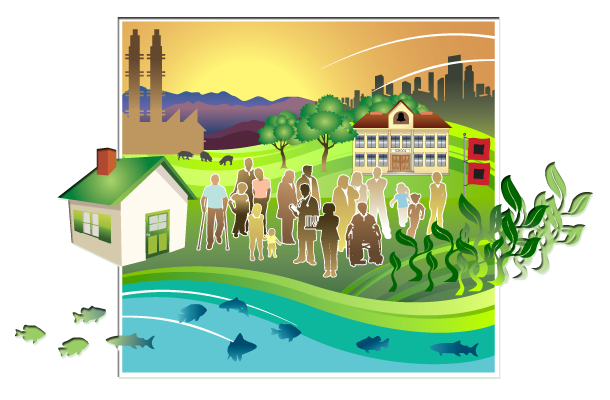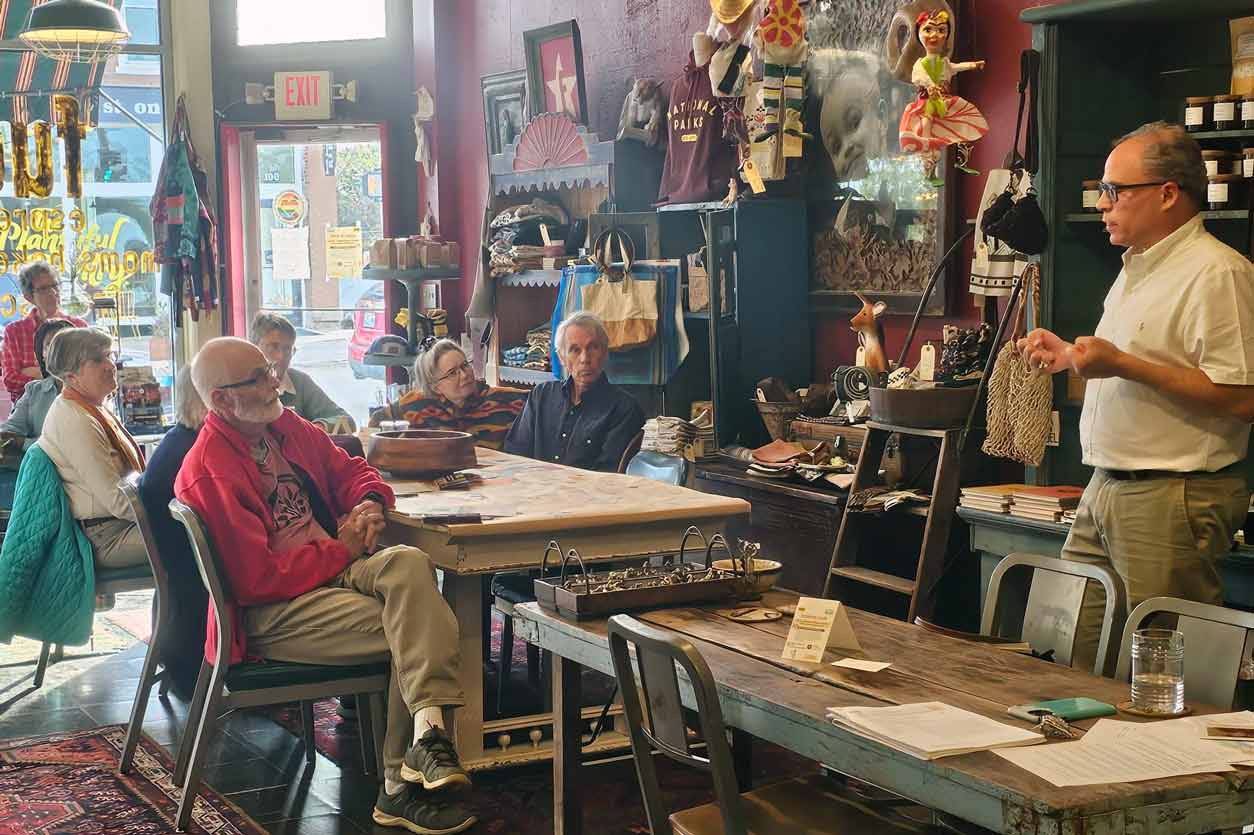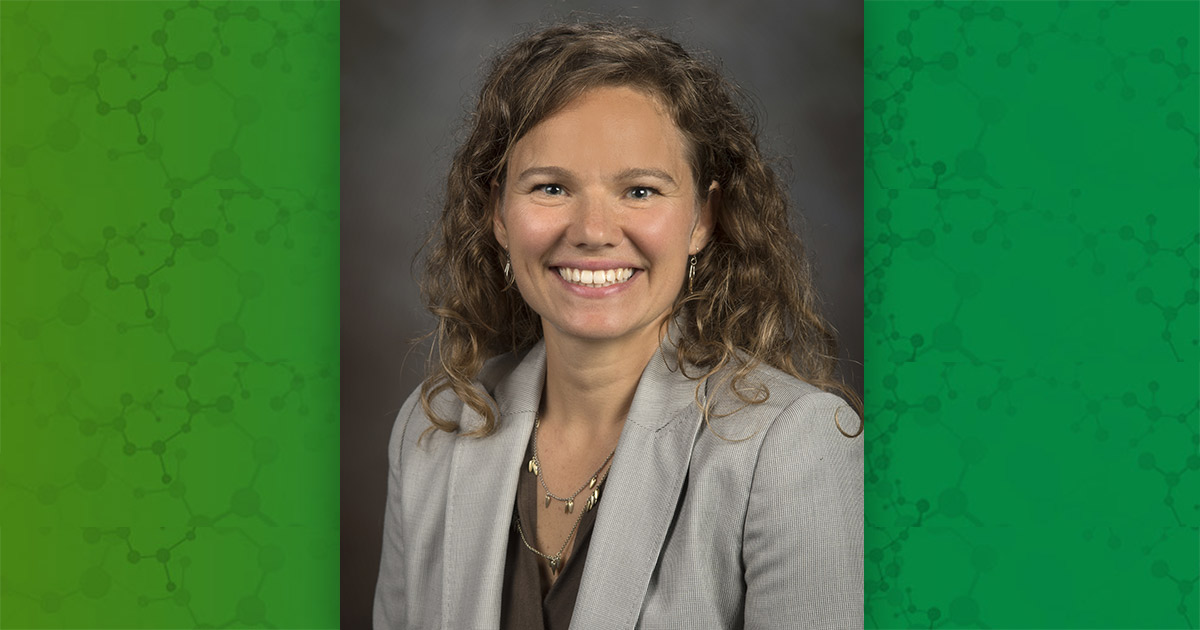An Environmental Justice and Health Forum Brings Together Grassroots Activists, Community Organizers, Regulators, and Researchers
As part of its mission to document and disseminate information about environmental justice and health inequities, a NIEHS-funded Environmental Health Sciences Center called THREE: Towards Health Resilience and Environmental Equity, located at the University of California, Davis (UC Davis), hosted a day-long environmental health and justice tour in March 2024. The tour went to several communities in the San Joaquin Valley. In collaboration with local community groups and advocates, the visits fostered dialogue between community-academic partners, state and federal regulatory agencies, and NIEHS leaders, including Rick Woychik, Ph.D., Director of NIEHS. The tour helped facilitate relationships that may make a positive impact on community members’ health and address environmental health concerns.
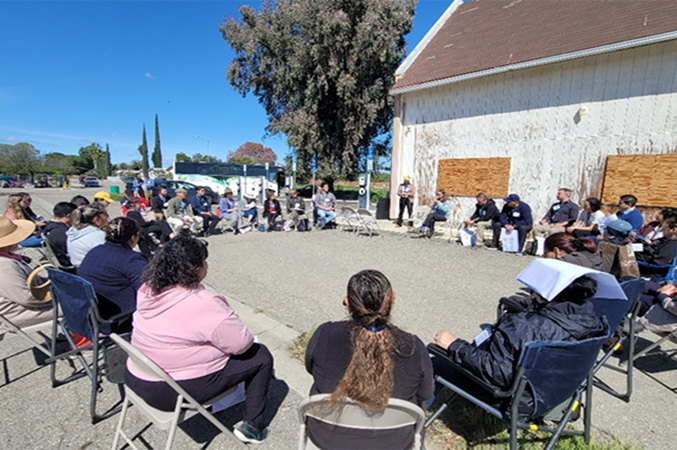
In the small farmworker town of Cantua Creek, residents, advocates, regulators, and scientists sit together in a circle to begin the dialogue. (Photo courtesy of Clarisse Cespedes)
The day began in the small, unincorporated communities of Cantua Creek and Lanare. These communities are classified by the state of California as Disadvantaged Communities, indicating that they are disproportionately affected by a combination of economic, health, and environmental burdens.
California’s San Joaquin Valley is a predominantly rural region with a rich, multicultural history, including serving as one of the birthplaces of the environmental justice and farmworker rights movements. It has a high proportion of low-income residents and is one of the most polluted regions in the country, experiencing high levels of toxic contamination in the air, water, and land, and notable health disparities including cancer, cardiovascular and chronic respiratory disease, and infant mortality.
Phoebe Seaton from Leadership Counsel for Justice and Accountability (LCJA) and Nayamin Martinez from the Central California Environmental Justice Network (CCEJN) shared perspectives on the cumulative impacts of pesticide exposures, water and air pollution, and lack of access to health services. Residents provided testimony on their experiences of toxic exposures, climate change, and inadequate government response to their concerns.
Drinking Water Systems in Crisis
Groundwater contamination is widespread throughout the San Joaquin Valley. Common contaminants include nitrates from agricultural runoff; pesticides; and arsenic, which is naturally occurring but can be worsened by overpumping and drought.
Lanare and Cantua Creek exemplify both the depth and complexity of these challenges. Like similar unincorporated communities in the San Joaquin Valley, Lanare and Cantua Creek were established in the 1950s by Black and Mexican farmworkers who settled in these isolated rural locations lacking electricity, running water, and other basic infrastructure.
When wells and pipes were installed in the 1970s and 1980s, Lanare’s water was found to contain toxic levels of arsenic. Cantua Creek’s wells soon became contaminated with nitrates from agricultural runoff. After decades of community advocacy, an arsenic treatment plant was built in Lanare in 2007, only to close six months later due to a lack of operating funds. In 2019, two new deep wells provided the town with arsenic-free water. However, residents still don’t feel safe to drink the water, reporting that it smells bad and leaves a residue on sinks and toilets. In Cantua Creek, residents pay high prices for tap water imported from another water district. Despite being treated, the imported water is considered unsafe to drink, and residents often have to rely on the state for bottled drinking water. Residents have been waiting for new wells, facing repeated delays, uncertainty, and mounting water debt.
“We live forgotten, unseen, neglected, with contaminated water. We have been fighting over this for years," said a Cantua Creek resident during the tour. "We … can't even use it for cooking, we don't even want to bathe with it."
The Impact of Pesticide Exposure
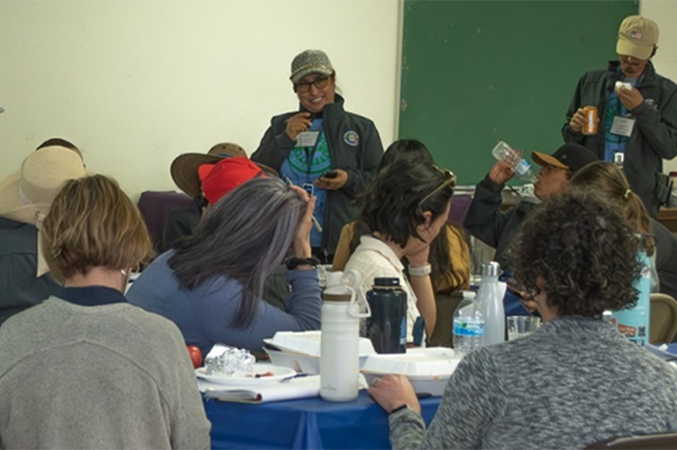
More than 20 volunteers from the Comunidad Unida de Lanare cook and set the tables to offer the guests a meal. Organization director Isabel Solorio gathers volunteers and says a prayer. (Photo courtesy of Clarisse Cespedes)
Pesticide exposure was also discussed on the tour. Farms in the San Joaquin Valley use more pesticides than any other region in California, and racial and economic disparities in pesticide exposures are stark, with agricultural workers, rural residents, and children being particularly vulnerable. Pesticide exposure has been linked to a wide range of acute and chronic health issues.
A resident who attended the tour reflected, "They don't notify [us] about pesticides. I worked doing this, and I know at night is when they spray the most. All night, tons [of pesticides] on almonds, pistachios ... and no warning.”
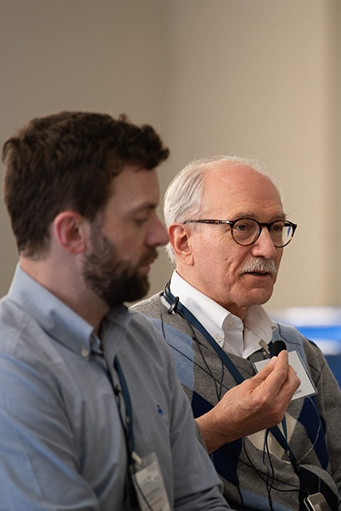
Rick Woychik, Ph.D., Director of NIEHS, attends the tour. (Photo courtesy of Clarisse Cespedes)
In interactive rotating stations, advocates Ruben Rodriguez from CCEJN, Mariana Alvarenga from LCJA, and Angel Garcia and Raul Garcia from Californians for Pesticide Reform (CPR) shared their work on key environmental justice and health issues such as pesticides, drinking water quality, air pollution, and climate change. In addition, UC Davis researchers discussed their work on air quality policy (Jonathan London), portable environmental health sensors (Nicholas Kenyon, Mitchell McCartney, Cristina Davis), utilizing citizen science approaches to test well water (Vida Sanchez, Jasqueline Peña), and using backpacks to sample pesticide exposure (Deborah Bennett collaborating with CPR).
Roundtable Discussion
The event at Lanare concluded with a roundtable discussion moderated by EHSC's Community Engagement Core faculty director, Jonathan London. The dialogue highlighted community environmental health concerns, requests of the regulatory agencies, and community research priorities to support and inform advocacy.
All parties expressed the importance of continuing dialogue particularly to bring attention to cumulative impacts – a goal that would necessitate an improved inter-agency and community collaboration.
As one regulator said, "We know you need answers. [And we realize that] 'sorry, this is another agency' [is not a good answer]. We need to stop working in silos.”
Members of the Lanare community urged the organizers to not let the forum be a one-time event, and the UC Davis team has committed to keep the conversation going through regular virtual meetings with agencies and scientists.
A Warehouse Boom in Fresno
On the way back through Fresno, participants were joined by Veronica Garibay (LCJA), who highlighted increasing industrialization in South-Central Fresno. A boom in warehouses, distribution centers, and factories has led to severe air pollution, including toxic diesel particulate matter. Advocacy groups are pushing for greater oversight of the environmental and health impacts of industrial development, as well as buffer zones between warehouses and daycares, schools, and hospitals.
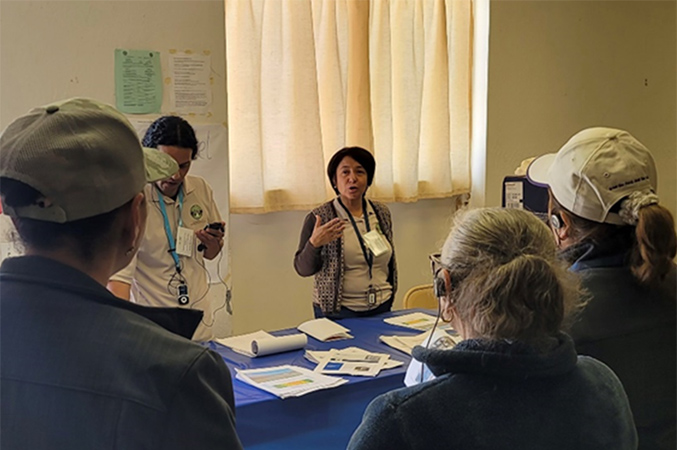
Nayamin Martinez at the Lanare Community Center. (Photo courtesy of Clarisse Cespedes)
The event ended with the leadership of NIEHS and the UC Davis Environmental Health Science Center THREE expressing their appreciation for the community residents and advocates for sharing their expertise and experiences and for the regulators for committing to address community issues.
The center wants to recognize original inspiration by Tanya Khemet (former co-director of the UC Davis Community Engagement Core) and the organizing brilliance of Nayamin Martinez (CCEJN). The PEPH newsletter team would like to acknowledge the UC Davis Environmental Health Sciences Center staff members Clarisse Cespedes and Shosha Capps, and community partners who contributed significantly to this article.
Nationwide Environmental Justice Climate Corps Launched, Applications Open in Early 2025
The U.S. Environmental Protection Agency (EPA) and AmeriCorps announced the Environmental Justice Climate Corps in September. Each corps member will serve for a year in the program, which is scheduled to run for three years and is meant to expand opportunities into environmental justice careers related to clean energy and a climate resilient economy. The corps will work toward supporting low-income and disadvantaged communities which are disproportionately affected by climate change. This initiative is EPA’s first nationwide service effort. The first round of applications is scheduled to open in early 2025, and the first cohort is expected to start later in 2025. Sign up for updates to learn more.
Heat-Related Rulemaking for Workplaces Now Open for Public Comment
Public comments are being accepted for the notice of proposed rulemaking on heat injury and illness prevention in outdoor and indoor work settings. Heat is a leading cause of death among weather-related phenomena. The Occupational Safety and Health Administration (OSHA) will issue a new standard based on the rulemaking that will apply to all employers in the following sectors where OSHA has jurisdiction: general industry, construction, maritime, and agriculture. The standard would require employers to create a plan for their workplace that addresses heat hazards. Currently, OSHA does not have a standard that regulates heat stress in the workplace, although other governmental entities have published regulations and guidance to promote worker safety with respect to heat hazards. Comments must be submitted by December 30, 2024.
U.S. Environmental Protection Agency Updates Equity Action Plan
The Environmental Protection Agency’s Meaningful Engagement Policy, released in August as an update to the 2003 Public Involvement Policy, describes how the agency will engage with the public and provide engagement opportunities in all its programs. The policy’s three steps are intended to help EPA staff design effective processes for public participation in a specific action, when appropriate. The first step is to understand the EPA action and key issues the public can inform. The next step is to select an appropriate level of public participation, based on the EPA’s Public Participation Spectrum, and to communicate how the public can participate. The final step is to select tools and practices using EPA’s public participation model to provide engagement opportunities. With the policy, EPA acknowledges that its actions to protect public health and the environment are stronger when informed by the communities it serves.

PEPH Grantee Highlight
Marilyn Howarth, M.D.
With a background in medicine, Marilyn Howarth, M.D., brings a unique perspective to research exploring the links between environmental exposures and human disease. Howarth directs the Community Engagement Core at the University of Pennsylvania (UPenn) Perelman School of Medicine’s NIEHS-funded Center of Excellence in Environmental Toxicology (CEET). CEET aims to translate findings on environmental exposures into measures to protect health. Howarth joined CEET in 2013 after a career in medicine in which she served in the Center for Disease Control’s Epidemic Intelligence Service, worked in a hospital, and taught at the UPenn Perelman School of Medicine. In her teaching role, Howarth taught about occupational and environmental health and launched an occupational health program to address industry exposures. In her current role, she focuses on projects that address community members’ concerns while reaching policy makers to enact solutions to those concerns.
Funding Opportunities
NIH Support for Conferences and Scientific Meetings (Parent R13 Clinical Trial Not Allowed)
Supports high-quality scientific conferences that are relevant to NIH's mission and to public health. A conference is defined as a symposium, seminar, workshop, or any other organized and formal meeting, whether conducted face-to-face or via the internet, where individuals meet for the primary purpose of exchanging technical information and views or exploring or clarifying a defined subject, problem, or area of knowledge, whether or not a published report results from such meeting. NIH encourages conference grant applicants to enhance diversity by increasing the participation of individuals from diverse backgrounds, including those from underrepresented groups, in the planning, implementation, and participation in the proposed conference. Eligible organizations include higher education institutions, nonprofits, for-profit organizations, local government (including Indian/Native American Tribal Governments), federal government, and other organizations such as faith-based or community-based organizations.
Deadline: December 12, 2024
PHS 2024-2 Omnibus Solicitation of the NIH, CDC, and FDA for Small Business Innovation Research Grant Applications (Parent SBIR [R43/R44] Clinical Trial Not Allowed)
Invites eligible United States small business concerns to submit Small Business Innovation Research (SBIR) Phase I, Phase II, Direct to Phase II (NIH Only), Fast-Track (NIH only), and Phase IIB (NIH only) grant applications. The SBIR/STTR Program Descriptions and Research Topics for NIH, CDC, and FDA represent scientific program areas that may be of interest to applicant small businesses in the development of projects that have potential for commercialization. SBIR applications that propose clinical trial(s) should be submitted to PA-24-246. Small business applicants interested in submitting an STTR grant application should submit to PA-24-247 or PAR-24-248.
Deadlines: January 5, 2025; April 5, 2025
Notice of Special Interest (NOSI): Innovative Technologies for Research on Climate Change and Human Health
This NOSI encourages grant applications from small business concerns to develop commercializable tools, resources, and approaches to capture the effects of climate change and the associated impacts of extreme weather events on human health, and to support adaptation or mitigation strategies to minimize health hazards and impacts from climate change. Technologies may include new approaches for detecting climate change-associated exposures, including temperature and air quality, training tools on climate change and mitigation strategies for patients with underlying health conditions, intervention approaches for reducing contaminants in water or in indoor air, modeling and prediction tools for climate change-related weather events and related health effects, and technologies for delivery of health care, including mental health services to communities during extreme weather events. This NOSI supports NIEHS’ Climate Change and Health Initiative. Applications are to be submitted through the SBIR (PA-24-245 or PA-24-246) or STTR (PA-24-247 or PAR-24-248) solicitations.
Deadlines: January 5, 2025; April 5, 2025
Notice of Special Interest (NOSI): Research on the Health of Women of Underrepresented, Underserved, and Underreported (U3) Populations (Admin Supp Clinical Trial Optional)
Encourages rigorous, collaborative, interdisciplinary research on the differential risk, treatment outcomes, and morbidity experienced by populations of women who are underrepresented, underserved, and underreported in biomedical research across the lifespan. Thoughtful incorporation of intersectionality and culturally and contextually relevant approaches into research by applying the National Institute on Minority Health and Health Disparities (NIMHD) Minority Health and Health Disparities Research Framework to meet group- and population-level needs is encouraged. Partnership between early career and independent investigators is encouraged to strengthen and accelerate multidisciplinary research in this space. The I-Corps program will be supported through administrative supplement awards to active SBIR (NIH and CDC) and STTR (NIH only) Phase I recipients. Administrative supplement awards are intended only to support travel and other direct costs associated with the training program. A cohort (up to 24 teams per cohort) will be selected to participate in the I-Corps at NIH program, which lasts approximately eight weeks.
Deadline: January 22, 2025
Innovation Corps (I-Corps TM) at NIH Program for NIH and CDC Translational Research (Admin Supp Clinical Trial NOT Allowed)
Provides three-member project teams with access to instruction and mentoring to accelerate the translation of technologies currently being developed with NIH and CDC SBIR and STTR funding. The participants conduct market research to identify where the company's technology can have greatest impact on unmet clinical needs.
Deadline: January 31, 2025
Dissemination and Implementation Research in Health (R01 Clinical Trial Optional)
Supports studies that will identify, develop, and/or test strategies for overcoming barriers to the adoption, adaptation, integration, sustainability, scale-up, and spread of evidence-based interventions, practices, programs, tools, treatments, guidelines, and policies. Studies that promote equitable dissemination and implementation of evidence-based interventions among underrepresented communities are encouraged. Conversely, there is a benefit in understanding circumstances that create a need to stop or reduce (de-implement) the use of practices that are ineffective, unproven, low-value, or harmful. In addition, studies to advance dissemination and implementation research methods and measures are encouraged. Applications that focus on re-implementation of evidence-based health services that may be disrupted amidst disasters (e.g., pandemics, climate change) remain relevant. Funding opportunities are also open for Dissemination and Implementation Research in Health (R03 Clinical Trial Not Allowed) and Dissemination and Implementation Research in Health (R21 Clinical Trial Optional).
Deadlines: February 5, 2025; June 5, 2025
Maximizing Opportunities for Scientific and Academic Independent Careers Postdoctoral Career Transition Award to Promote Diversity (K99/R00 Independent Clinical Trial Not Allowed)
Supports a cohort of early career, independent investigators from diverse backgrounds (for example, individuals from underrepresented groups) conducting research in NIH mission areas. The program has two components: an individual career transition award for postdoctoral scholars (K99/R00) and a research education cooperative agreement (UE5) awarded to organizations to provide these scholars with additional mentoring, networking, and professional development activities to support their transition to and success in independent, tenure-track or equivalent research-intensive faculty careers. This Notice of Funding Opportunity (NOFO) is designed specifically to support candidates proposing research that does not involve leading an independent clinical trial, a clinical trial feasibility study, or an ancillary clinical trial. Candidates seeking support through this NOFO are permitted to propose a research experience in a clinical trial led by a mentor or co-mentor. Candidates proposing a clinical trial or an ancillary clinical trial as lead investigator, should work with their institutions to apply to the companion NOFO PAR-24-226. Candidates proposing to work on basic experimental studies with humans should apply to PAR-24-227.
Deadlines: February 12, 2025; June 12, 2025
Support for Research Excellence (SuRE) Award (R16 Clinical Trial Not Allowed)
Supports research capacity building at institutions that award baccalaureate and/or graduate degrees in biomedical sciences and receive limited NIH Research Project Grant funding. SuRE-supported projects must have student participation in the execution, analysis, and reporting of the research. An applicant institution must demonstrate a commitment to build its research capacity and support for the program director/principal investigator of the award. This funding opportunity requires a Plan for Enhancing Diverse Perspectives as described in NOT-MH-21-310, submitted as Other Project Information as an attachment (see Section IV). Applications submitted to this funding opportunity for consideration by NIEHS must have a research focus on exposure-health-related responses from environmental agents within the mission interest of NIEHS (e.g., industrial chemicals or manufacturing byproducts, metals, pesticides, herbicides, air pollutants and other inhaled toxicants, particulates or fibers, fungal, and bacterial or biologically derived toxins). The Support for Research Excellence – First Independent Research (SuRE-First) Award (R16 - Clinical Trial Not Allowed) is also open. The purpose of this funding opportunity is to support faculty investigators who have not had prior independent external research grants, to furnish students with high-quality undergraduate and/or graduate research experiences and to enhance the institutional scientific research culture.
Deadline: May 28, 2025
Upcoming PEPH-related Events
EPA Tools and Resources Training Webinar Series: ECOTOX Knowledgebase and PFAS Updates. EPA provides detailed overviews and tutorials on its popular tools. The December webinar will focus on updates on PFAS and on the Ecotoxicology (ECOTOX) Knowledgebase Resource Hub, which provides information on the adverse effects of chemical stressors to ecologically relevant species. Registration for the training webinar is available.
U.S. Department of Transportation Webinar: Parking Reform as a Climate Strategy. This webinar is part of a series on climate change and transportation, hosted by the Department of Transportation’s Climate Change Center. Register for the parking reform webinar.
U.S. Department of Transportation Webinar: Navigating Climate Challenges and Enhancing Transportation Resilience. This webinar is part of a series on climate change and transportation, hosted by the Department of Transportation’s Climate Change Center. Register for the transportation resilience webinar.
Our Planet, Our Health: 2025 Climate Action Convention - The Medical Society Consortium on Climate and Health (MSCCH) (Washington, DC). The MSCCH convention will bring together leaders, experts, and advocates in health and sustainability. The convention will provide insights on research into the links between ecological drivers and health outcomes, explore strategies for building resilience and equity in the face of climate challenges, and inform on ways to advocate effectively for policy change. Registration will open soon. Abstract submissions for posters or oral presentations will be open on December 2, 2024. Submissions will be accepted until March 10, 2025. Registration for the conference will open at a later date.
Association for Advancing Participatory Sciences: 2025 Conference for Advancing Participatory Sciences (Portland, Oregon). The 2025 Conference for Advancing the Participatory Sciences will feature workshops, collaborative discussions, networking events, and symposia to promote the participatory sciences. The conference brings together researchers, facilitators, and community leaders. The call for individual presentations is open until January 15, 2025. Registration for the conference will open in early 2025.
Interdisciplinary Association for Population Health Science (IAPHS) 2025 Conference (Pittsburgh, Pennsylvania). The theme of the 2025 IAPHS annual conference will be “Community Engagement in Population Health Science” to recognize that communities hold the solutions to population health challenges and health inequities. The conference will include talks on methods, funding, and translation to policy.




